In 1972, Ferdinand E. Marcos declared Martial Law in the Philippines. This had a big impact on education, making it harder for students to think freely. It also made it tough for them to learn the truth about this time in history.
Today, social media is full of fake news, especially about Martial Law. The government has even spread false information. Only 33% of Filipinos go to college, so many miss out on learning about Martial Law’s effects on education.
Teaching about Martial Law is hard because of old textbooks. Since Marcos left, textbooks have gotten better, but not all are good. The Marcos family uses social media to change how people see them, making it harder to teach the truth.
Key Takeaways
- Martial Law was declared in the Philippines in 1972, affecting the country’s education system and leading to a decline in academic freedom.
- Historical revisionism is a significant challenge in Philippine education, with many students not receiving accurate information about Martial Law.
- The participation rate of Filipinos in higher education institutions is only 33%, indicating a lack of mature discussion of Philippine history.
- The government’s communications department has been involved in misinformation about Martial Law, highlighting the issue of inaccurate information in educational materials.
- The Philippine education system relies heavily on textbooks, which can have varied content quality due to liberalized production since the ouster of Marcos.
- The rise of misinformation about Martial Law and the Marcos regime is attributed to the increased presence of alternative information sources like TikTok, YouTube, and Facebook, affecting Philippine education.
The State of Philippine Education Before Martial Law
In the 1960s, the Philippine education system was among the best in Asia. It had a high adult literacy rate. Education was crucial for the country’s economic growth. However, the system faced issues like a lack of resources and infrastructure.
The government tried to improve education by setting up a national system and promoting vocational training. Yet, many Filipino students still found it hard to get quality education.
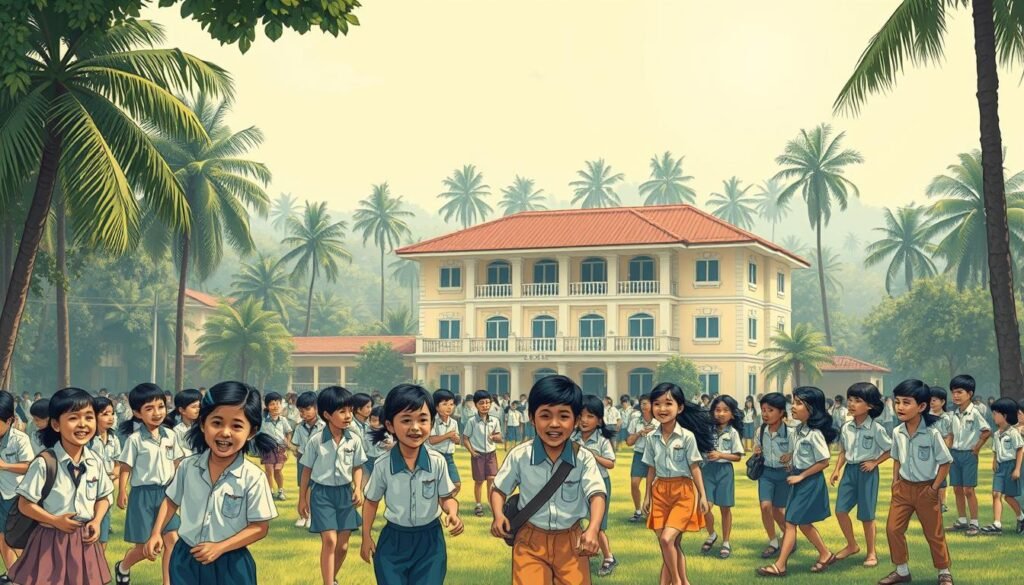
In the 1960s, the government wanted a curriculum that was relevant and flexible. It focused on skills in food production and natural resource conservation. The goal was to enhance manpower through education in land reform, taxation, and more.
Some important facts about education in the Philippines back then include:
- High rate of adult literacy
- Lack of resources and infrastructure
- Emphasis on vocational training and national education system
- Challenges in accessing quality Philippine education
Declaration of Martial Law and Initial Educational Reforms
The declaration of Martial Law in 1972 was a big change for Philippine education. The new government brought in educational reforms. They created a national education system and pushed for more vocational training.
President Marcos declared Martial Law in 1972. He said it was to fight rising disorder and threats from the Communist Party of the Philippines and the Moro National Liberation Front. This led to a period of one-man rule, lasting until February 25, 1986. During this time, the government made several educational reforms. They also created the Department of Education and Culture in 1972.
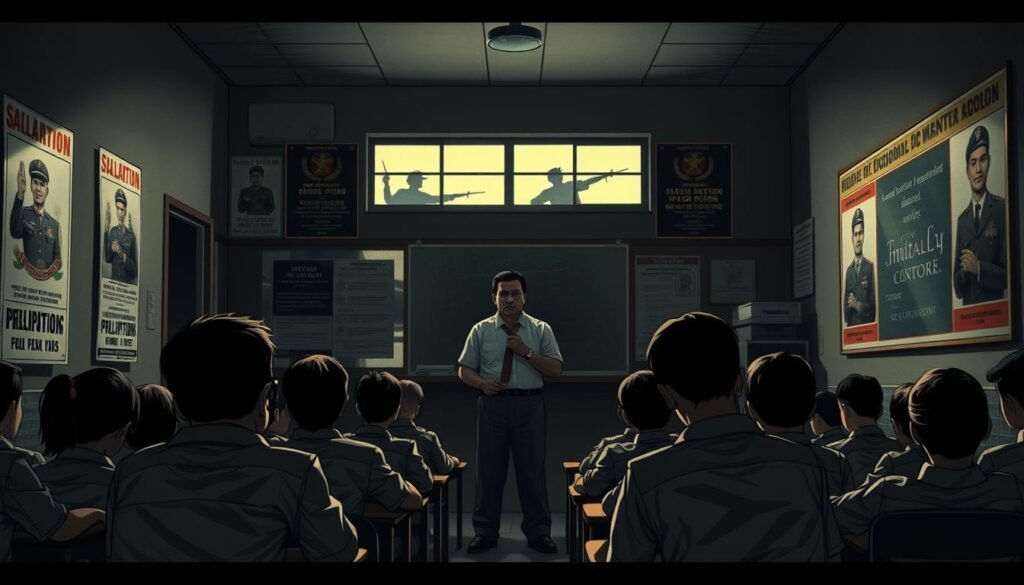
The Martial Law period brought big changes to education. There was a focus on vocational training and national development. But, these changes also led to less academic freedom and less critical thinking. The government wanted to control what and how students learned.
Some of the key educational reforms during this time include:
- Establishment of a national education system
- Promotion of vocational training
- Creation of the Department of Education and Culture
These reforms had a lasting impact on Philippine education. They shaped the country’s educational landscape for many years.
The Department of Education Under Martial Law
The Department of Education was key in enforcing the government’s education plans during Martial Law. It saw major changes, like new units and officials. This change made education focus more on job skills and national pride.
The education budget was cut down, and schools lacked the basics. The education budget fell from over 33% to just 9% after 1972. This big cut hurt the quality of education in the Philippines.
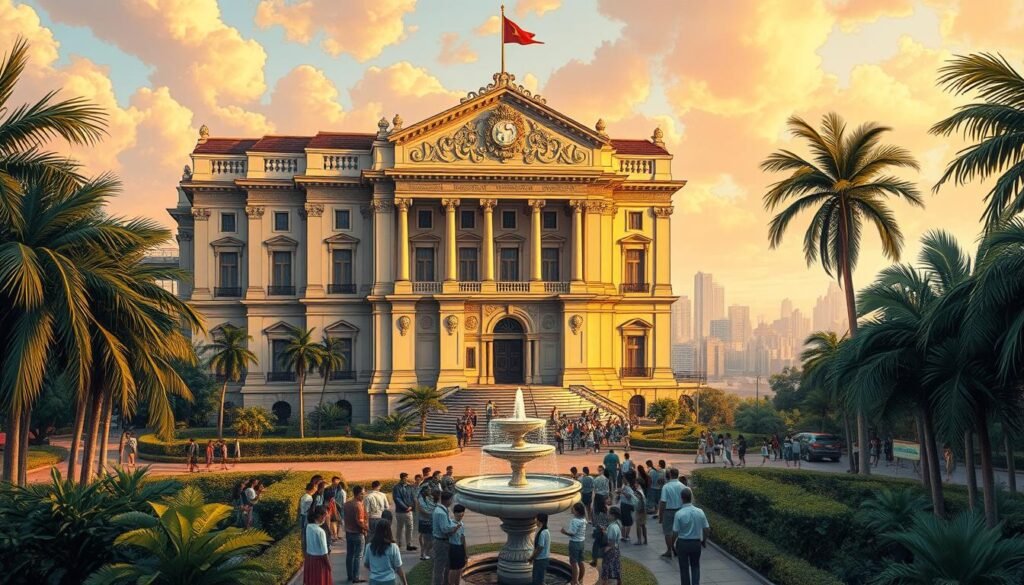
Some big challenges for the Department of Education during Martial Law were:
- Limited resources and infrastructure
- Low budget allocation for education
- Lack of basic facilities and equipment in schools
To tackle these issues, the Department introduced new education policies. These included more job training and teaching national pride. But, whether these policies worked well is still debated.
Martial Law greatly affected the Department of Education and education policies in the Philippines. Education’s focus shifted to job training and national pride. The Department’s efforts to meet these challenges are still influencing education today.
Curriculum Changes During the Martial Law Era
Martial Law in the Philippines brought big changes to schools. The government wanted to teach a national identity and loyalty. So, they updated school lessons to include civic education and national history.
But, these changes hurt academic freedom and critical thinking. The education system became more about the government’s views. Teachers had to stick to a biased curriculum. Students were not encouraged to question or challenge the government’s rule.
Now, there’s a push to make history lessons better. The University of the Philippines is leading this effort. Other schools, like DLSU, want to add a Martial Law subject to the curriculum. They aim to give students a fair view of Martial Law’s impact on education.
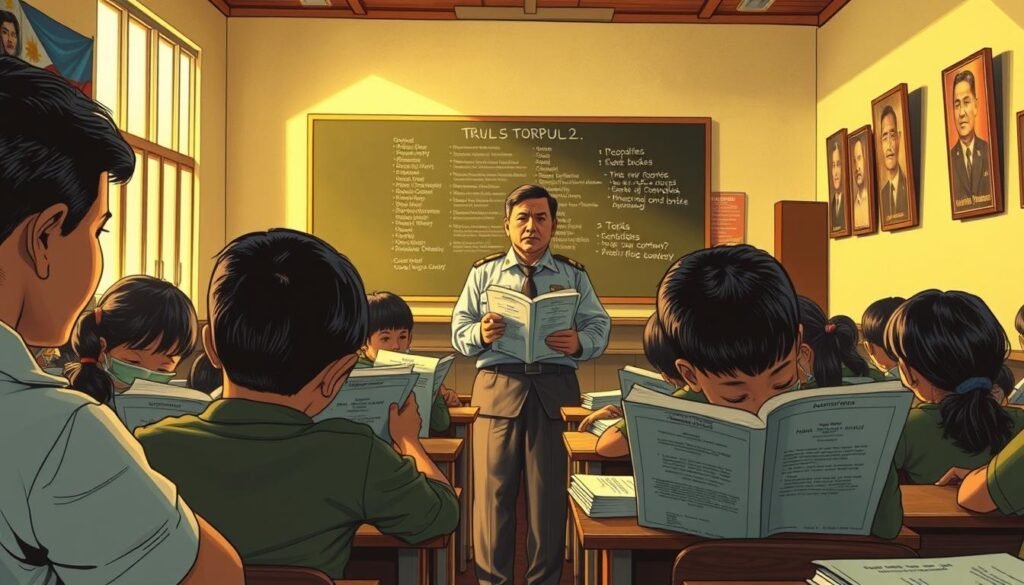
Some important facts about Martial Law education in the Philippines are:
- Filipino students will learn about martial law from Grade 2 on.
- The current curriculum includes martial law lessons in many subjects for all school levels.
- There’s talk about adding a special martial law subject to the curriculum.
The Martial Law era deeply affected the Philippines’ education system. It’s crucial to keep working on teaching students about this important time in history.
Language Policies in Philippine Education
Language policies have greatly shaped the Philippine education system. The use of English as the main teaching language has boosted the country’s economy. A study found that by the end of American rule, over 35% of people could speak English. This has had a lasting effect on language policies in schools.
The growth of the Filipino language is also a key focus. The government aims to make Filipino the national language. At the same time, it considers the role of local languages in education. Some important points include:
- Teaching regional languages to celebrate cultural diversity and understanding
- Teaching English to prepare students for the world and job opportunities
- Developing Filipino to strengthen national identity and unity
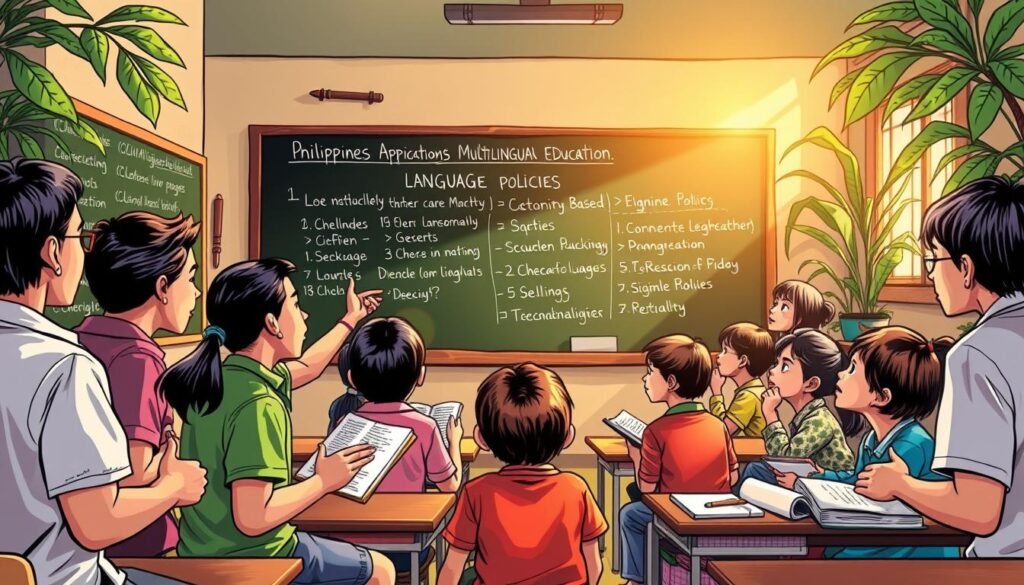
Language policies in Philippine education aim to find a balance. They want to support global communication while keeping national and regional languages alive. By understanding the history and context of these policies, educators and policymakers can create a better, more inclusive education system.
Higher Education Reforms and University Life
The Philippines has made big strides in making higher education more accessible. There are now 228 state universities and colleges, with 1.88 million students in the 2015/16 year. Yet, there’s still a need for better skills to boost the workforce.
Employers in the East Asia and Pacific region, including the Philippines, want workers with problem-solving, communication, and management skills. These skills are key to higher productivity.
Reforms in higher education are vital to close the skills gap and boost research that meets economic needs. The Philippine government is working on reforms to make the education system more relevant to development. This includes a pause on new colleges and universities.
They’re also getting rid of substandard programs and setting up research and development centers. This will help improve the quality of higher education.
Some key initiatives to enhance higher education include:
- Improving public resource allocation, with a focus on STEM and equity
- Granting autonomy to universities, particularly in staffing and finance
- Enhancing private higher education quality through better information
- Encouraging university-industry linkages to enhance curriculum relevance and support entrepreneurship

These reforms aim to better the quality of graduates, address skills gaps, and increase relevant research. By doing this, the Philippines can keep improving higher education quality. This will help with sustained economic growth, productivity, and competitiveness.
Student Movements and Academic Freedom
The Martial Law era in the Philippines was tough on student movements and academic freedom. The government tried to keep a tight grip on campus activism. Many student leaders faced arrest or detention.
There were big protests and demonstrations back then. The First Quarter Storm of 1970 was a key moment. It was a student-led event that also involved laborers and farmers.
Important student groups like the Kabataang Makabayan, started in 1964, and the League of Filipino Students, founded in 1977, emerged during this time. These groups fought against imperialism and pushed for social justice. Their efforts showed the strong will to make a difference.
Today, academic freedom and campus activism are still big concerns in the Philippines. The end of the UP-DND Accord in 2021 has raised worries about watching dissenting voices in universities. The Anti-Terrorism Law has also led to more attacks on activists and those who speak out.
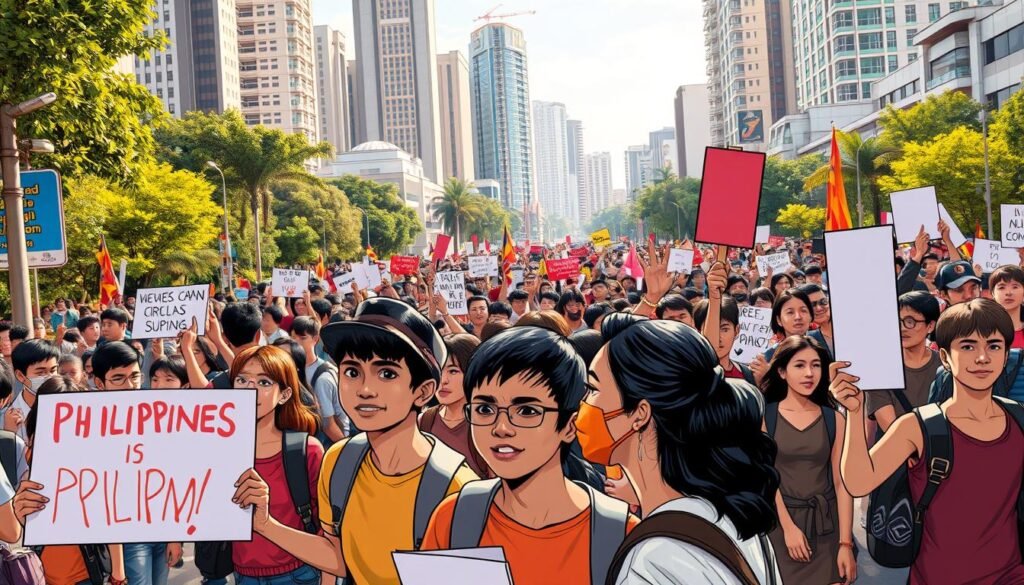
Here are some important facts about student movements and academic freedom in the Philippines:
- In 1969, Ferdinand Marcos Sr.’s reelection led to big student strikes in Manila.
- The First Quarter Storm of 1970 saw students, laborers, and farmers come together in demonstrations.
- The 1986 People Power Revolution was the result of years of struggle. It made students and activists more aware of politics.
The Role of Propaganda in Educational Materials
During Martial Law, propaganda was key in shaping educational materials in the Philippines. The Marcos regime wanted to show itself in a good light. This led to biased and false educational materials aimed at young Filipinos.
A clear example is a senior high school module that called Martial Law a “Period of the New Society.” This was a false portrayal of a time of change. Such propaganda has long been a problem, altering history to favor those in power.
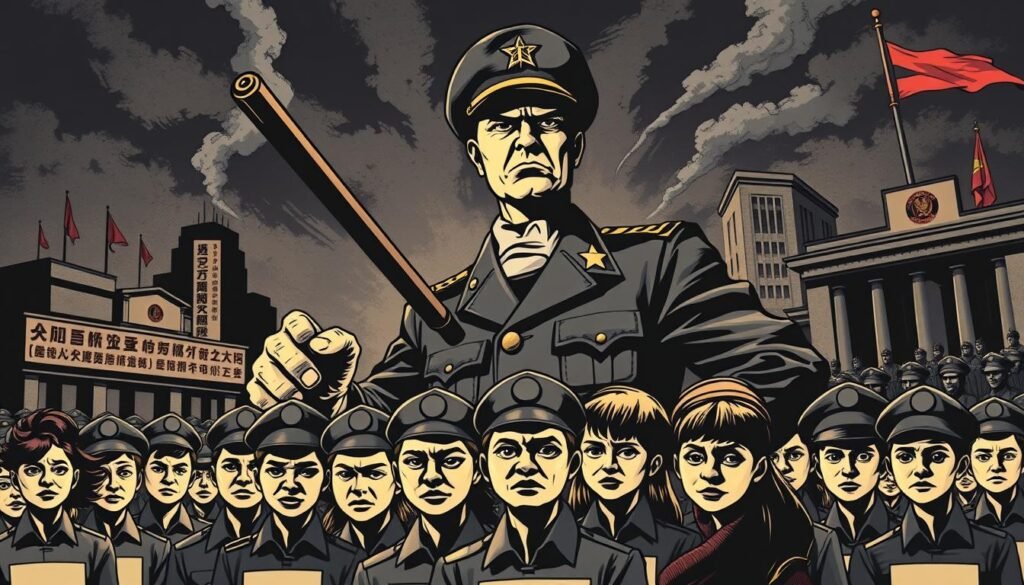
The effect of propaganda in educational materials during Martial Law is still felt today. It has hurt critical thinking and academic freedom. It also made many unaware of the Philippines’ real history. Now, there are efforts to fix this, like adding Philippine History to high school and correcting learning modules.
Some numbers show Martial Law’s impact: 70,000 arrests, 34,000 tortured, and 3,240 killed outside of war. Agricultural workers’ income fell by 30% under Marcos Sr. Farmers’ daily earnings dropped from PHP 42 in 1972 to PHP 30 by 1986. These facts show why we need honest and unbiased educational materials to understand our history.
Impact on Teachers and Educational Professionals
The Martial Law era greatly affected teachers and educational professionals in the Philippines. The government changed the education system, requiring teachers to learn about civic education and national history. A study on education research shows that teachers’ readiness is key to successful reforms.
Teachers are crucial in shaping the next generation. Yet, they face heavy workloads and limited resources. The Civil Service Commission (CSC) Resolution No. 080096 requires teachers to work 8 hours a day, 40 hours a week. Despite these hurdles, teachers still get good performance ratings, research shows.
Some important statistics about teachers’ challenges include:
- Republic Act No. 4670 limits classroom time to 6 hours a day for teachers.
- Teachers handle more than just teaching, including admin work and training.
- Teachers are happy with their jobs when they have good supervision and job security.
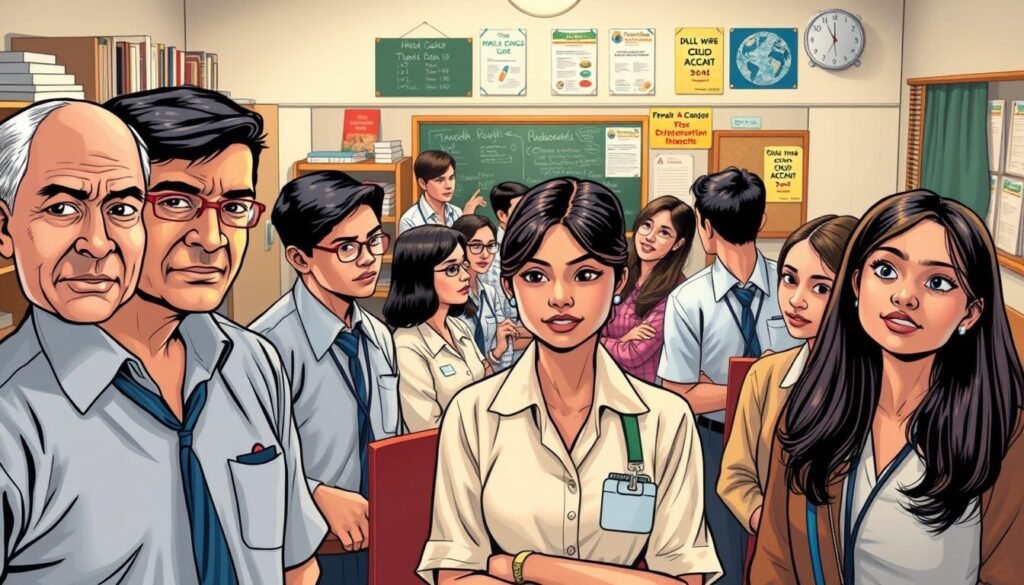
There are efforts to help teachers and improve education. The Department of Education (DepEd) aims to reduce admin tasks. The National Economic and Development Authority (NEDA) focuses on developing human capital. By tackling teachers’ challenges, the Philippines can enhance its education system and improve student outcomes.
Rural Education Initiatives During Martial Law
The rural education sector in the Philippines faced big challenges during Martial Law. Despite these, the government started rural education projects to help. These projects included opening new schools and promoting vocational training.
The Department of Education said the curriculum changes aimed to teach nationalism and patriotism. But, many criticized these changes for being too focused on the government’s views.
Some key efforts during this time were:
- Building new schools in rural areas
- Boosting vocational and technical education
- Introducing a new curriculum that stressed nationalism and patriotism
These efforts had some good outcomes. Yet, they also led to less academic freedom and less critical thinking. Rural schools had to follow a curriculum that favored the government’s views. Students were not encouraged to question or challenge the current system.
Private Education Under Martial Law
During martial law, private education in the Philippines saw big changes. The government made regulation changes that affected private schools, including religious schools. These changes deeply impacted the education system, making it hard for private schools to keep their freedom and academic standards.
A report by the Department of Education showed a drop in academic freedom and critical thinking in private schools. Many private schools had to follow a curriculum that supported the government’s views. Students were not encouraged to question or challenge the current situation.
The status of religious schools was also hit hard, with many facing limits on their freedom of speech and assembly. The government’s regulation changes had a big impact on education, making it tough for private schools to keep their independence and academic freedom. Despite these hurdles, many private schools kept offering quality education. Some even helped promote critical thinking and academic freedom.
Statistical Analysis of Philippine Education 1972-1986
The years from 1972 to 1986 saw big changes in the Philippines’ education. A statistical analysis of this time shows a complex picture. A study found that college enrollment in the Philippines grew a lot since the 1950s. By the 1980s, 33.78% of those born between 1950 and 1954 had finished college.
Some important facts from this time are:
- By the mid-1980s, education spending was less than 2% of GDP.
- In 1985, the Philippines hit its worst economic downturn.
- By the 1970s, more people were going to college, greatly affecting Philippine education from 1972-1986.
The statistical analysis of Philippine education during this time shows a need for more investment in education. This is to help the economy grow and develop. As the country moved past martial law, it was clear that Philippine education from 1972-1986 had a lasting effect on the nation’s progress.
Long-term Effects on Modern Philippine Education
The Martial Law era has left a lasting mark on modern Philippine education. Many changes from that time are still seen today. The long-term effects of Martial Law on education are still being felt. It’s crucial to tackle these issues to make education fair, accurate, and effective.
Some key statistics show the current state of Philippine education. In 2020, the literacy rate was 97%, with females at 97.1% and males at 96.8%. Yet, the country faces big challenges. There’s a deficit of 91,000 classrooms for the 2023-2024 school year and a shortage of 86,000 teachers. The
The long-term effects of Martial Law on education are complex. Some major issues include:
- A decline in academic freedom and critical thinking
- A biased and inaccurate version of history being taught in schools
- A shortage of resources, including classrooms and teachers
- A significant mismatch between training and actual job availability
Fixing these issues is key to making the modern Philippine education system work well. By understanding the long-term effects of Martial Law on education, we can build a better future for the country’s education.
Conclusion: The Educational Legacy of the Martial Law Era
The Martial Law era in the Philippines has had a lasting effect on education. As discussed in the analysis of the educational legacy of this period, it is clear that the regime’s influence on education was profound. The educational legacy of the Martial Law era is complex, with significant declines in academic freedom and the suppression of critical thinking.
The use of propaganda in educational materials has contributed to a decline in critical thinking and academic freedom. The long-term effects of Martial Law on Philippine education are still being felt, with a significant portion of the electorate lacking a comprehensive understanding of this period in history. It is essential to address these issues to ensure that the education system is fair, accurate, and effective, providing students with a thorough understanding of the Martial Law era and its impact on the country.
In conclusion, the educational legacy of the Martial Law era is a critical aspect of Philippine history, and it is essential to remember and learn from this period to ensure that the mistakes of the past are not repeated. By examining the educational legacy of the Martial Law era, we can gain a deeper understanding of the complexities of this period and work towards creating a more comprehensive and critical approach to education in the Philippines.
FAQ
What was the state of Philippine education before the imposition of Martial Law in 1972?
Before Martial Law, the Philippines had a well-developed education system. Adult literacy rates were high. Education was seen as key to the country’s growth. Yet, the system faced challenges like a lack of resources and infrastructure.
How did the declaration of Martial Law in 1972 affect the Philippine education system?
Martial Law changed Philippine education significantly. It led to less academic freedom and less critical thinking. The government introduced reforms, like a national education system and vocational training. But, these came with strict rules on what and how to teach.
What changes occurred in the curriculum of Philippine schools during the Martial Law era?
The curriculum was updated to include civic education and national history. These subjects aimed to show the government in a good light. But, this also meant less freedom in teaching and more focus on the government’s views.
How did language policies affect Philippine education during the Martial Law era?
The government pushed for English as the main teaching language. This was seen as a way to boost the economy. Yet, there were challenges like a lack of resources. The government also wanted to promote the Filipino language as part of national identity.
What impact did Martial Law have on higher education in the Philippines?
Martial Law brought reforms to higher education, like new universities and vocational training. But, these changes also meant less freedom in teaching. Universities had to follow a curriculum that supported the government’s views.
How did the Martial Law era affect student movements and academic freedom in the Philippines?
Martial Law suppressed student movements and academic freedom. The government controlled campus activism and arrested many student leaders. Teachers and professors faced restrictions on what they could say and teach.
What role did propaganda play in educational materials during the Martial Law era?
Propaganda was key in education during Martial Law. The government wanted to show itself in a positive light. Educational materials were designed to do this, but it also affected what students learned, often teaching them biased and incorrect history.
How did the Martial Law era affect teachers and educational professionals in the Philippines?
Teachers and educators faced big changes during Martial Law. They had to teach a curriculum that supported the government. Teaching requirements changed, and professional development was limited and not very effective.
What initiatives were implemented in rural education during the Martial Law era?
Martial Law saw efforts to improve rural education, like new schools and vocational training. But, these efforts also meant less freedom in teaching. Rural schools had to follow a curriculum that supported the government’s views.
How did the Martial Law era affect private education in the Philippines?
Private education saw changes during Martial Law, like new rules and vocational training. But, these changes also meant less freedom in teaching. Private schools had to follow a curriculum that supported the government’s views.
What are the long-term effects of Martial Law on modern Philippine education?
Martial Law’s impact on education is still felt today. The decline in academic freedom and critical thinking has lasted. Students still learn biased and incorrect history. The use of propaganda in education has also hurt critical thinking and freedom.
Source Links
- Remembering martial law in the Philippines: Education and media – New Mandala
- How Philippine Education Contributed to the Return of the Marcoses
- A History of the System of Education in the Philippines – Its Implication for the Present Generation
- Education in the Philippines
- Philippines – Martial Law, Marcos, Dictatorship | Britannica
- History | Department of Education
- Martial law under Ferdinand Marcos
- Martial Law education pushed to keep memory of abuses alive
- The Philippine Education System Three Decades after the Passage of the Education Act of 1982
- Literacy Declining : Philippines: New Crisis in Education
- Figuring out why Martial Law education remains neglected in PHL curricula
- Martial law and the miseducation of our youth
- Students to be taught concepts on martial law
- Ideologies underlying language policy and planning in the Philippines – Humanities and Social Sciences Communications
- Philippine Policies in Native Language Learning and Literacy among High School Students
- Education reform in the Philippines aims for better quality and more access – Asia 2017 – Oxford Business Group
- PHILIPPINES: Reforms in Higher Education Key to Growth and Competitiveness
- Higher education reforms key to growth in Phl -report
- Academic Freedom Makes an Informed and Empowered Citizenry
- Activism is Under Attack in the Philippines – Democratic Erosion
- To be truly "revolutionary" university activism should espouse original ideas and not OBSOLETE ones
- Propaganda Movement | Facts, Definition, & History | Britannica
- Rewriting History: Learning or Propaganda? | CMFR
- Educational Challenges in the Philippines
- Frontiers | An exploration of the quality of graduates of Philippine teacher education institutions
- Education in the Philippines
- Living Marcos’ Martial Law Through My Parents’ Eyes
- The perils of teaching martial law as history
- Martial law simulations: How one school teaches kids the EDSA revolution
- History teachers, activists teach the youth on the lessons of Martial Law
- At all costs: educational expansion and persistent inequality in the Philippines
- Five things to know about Martial Law in the Philippines
- The Philippines’ Dangerous Dependence on the Exploitation of its People – New Naratif
- Philippine Education Today: Challenges, Opportunities
- Overview of Philippine Education – iEducationphl
- Education Issues in the Philippines: The Ongoing Struggle
- On Martial Law at 50: Fact-Checking the Marcos Story, Countering the EDSA History | Heinrich Böll Foundation | Southeast Asia
- Unpacking Marcos martial law regime | Daily Guardian

